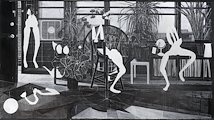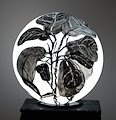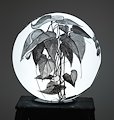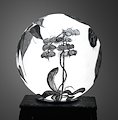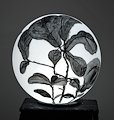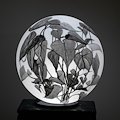A SECOND BODY at EQUITY GALLERY, MAR 5 - 29, 2025
Description
EQUITY GALLERY 245 Broome St NY NY
MARCH 5- MARCH 29
opening March 5th, 6-8PM
Artist Talk March 22, 3-5PM
Catherine Lepp will be presenting a new body of work in a solo exhibition curated by Karen Wilkin for Equity Gallery. The show features large-scale, black and white works on paper, canvas and plastic globes depicting the artist’s studio and its attendant props – foremost a three-quarter-sized, home-made, sexless, headless pantyhose puppet.
Despite the art-world’s seemingly inexhaustible obsession with passing trends, one constant, that of the artist working from the live model, remains largely intact. That persistence is notable given the abundant array of materials and processes informing contemporary art production — suggesting that the challenge of arriving at a compelling plastic expression in response to the human body still resonates.
Beyond the aesthetic exchange informing the artist-model pairing, there are consistent examples throughout art history whereby artists, motivated by love and/or economic necessity, enlisted their lovers and marital partners as studio models. Salai’s famed angelic beauty won him a modeling spot (with room and board) in Leonardo DaVinci’s workshop in spite of his incorrigible philandering. Pierre Bonnard painted his wife Marthe, who never aged and seemed forever to be bathing. Pablo Picasso, with an oeuvre saturated with paintings of his numerous wives and lovers, heads the procession of artists indebted to their model/muses.
So seemingly attached is art making to the human body that the need for a reasonable substitute arose when no living bodies could be pressed into service. Hence the invention of the artist’s mannequin, a stand-in well able to withstand the rigor (in fetishistic stillness) of six-hour poses. From William Hogarth to Thomas Gainsborough, artists employed mannequins, and like the live models they replicated, these understudies became objects of love and desire. Oskar Kokoschka treated his as a surrogate companion and is rumored to have beheaded it when the love affair soured.
Catherine Lepp’s substitute muse is a near life-sized, artist-made, sexless, headless pantyhose puppet tied up with strings, clamped into place for each pose and stuffed into a suitcase when not in use. Hardly loveable. Lepp adds, “My latest works are inhabited by a second body made from pillows, metal coat hangers, and hosiery. She/It has legs, a torso and arms, but no head and it can’t stand up.” Flopping about, spineless, and as charming as a post-coital praying mantis, Lepp’s puppet is an eye-stopping response to Titian’s boneless, pillowy reclining nudes. She/It appears centerstage in a series of mural-scale, black and white interiors depicting the artist’s studio re-imagined as a black box theater. Teetering suggestively, if not impossibly, on a flattened cubist idea of a stool, Lepp’s “second body” is joined by a random ensemble of studio objects — among them potted plants, window fans, an owl figurine, a propped-open door — their appearances distilled to a Sumi Master simplicity. Seen in a coruscating light, these staged compositions recall Tintoretto’s candle-lit modellas, their unstable illumination captured with a brush loaded with white lead speed-skating across a midnight ground.
There’s a lot to see and analyze in these works. Lepp’s “second body,” grotesque and starkly silhouetted in ghostly white, belies the absence of the live model rather than offering a believable facsimile. Similar paradoxes abound; the modeling of still-life objects and background architectural elements are suppressed, yet they are grounded on an insistent perspectival grid. Simultaneously suggesting illusionistic pictorial space while amplifying each object’s flatness, the compositions dissolve into surface patterns and resound with a dissonant, yet captivating, spatial tension. Narrative scale distortions and the blurring of distinctions between inside and outside space offer additional signposts suggesting that Lepp’s “second body” has one foot in the Renaissance and one in the Middle Ages, allowing her to rummage through art histories cherry-picking strategies best suited to touring her viewers through the make-believe twilight world that is the artist’s studio.
Date
March 5 – 29, 2025






